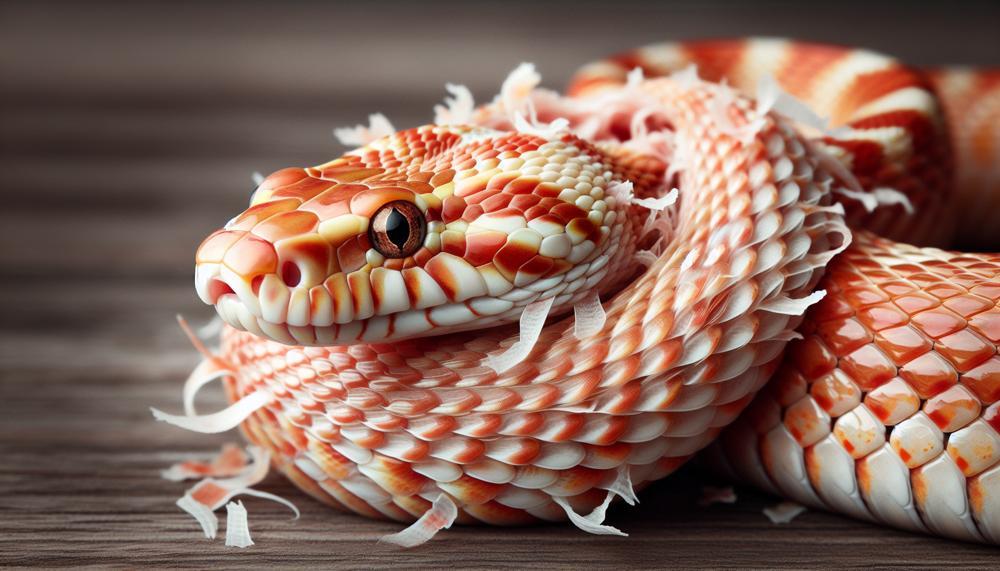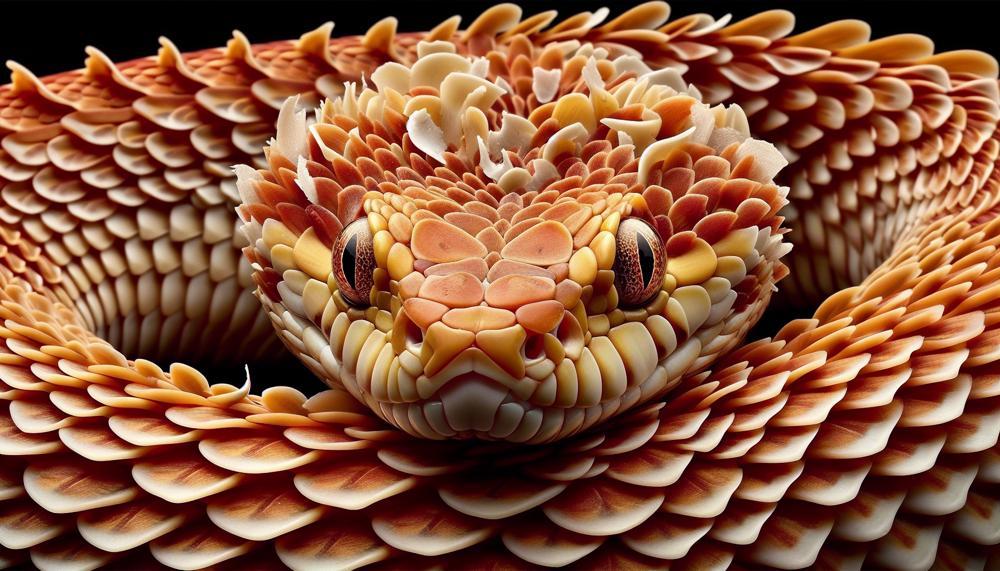Do you proudly own a magnificent corn snake, but find yourself constantly cleaning up shed skin? Fear not, for you are not alone in this struggle.
Shedding is an essential and natural process for all snakes, including our beloved corn snakes. But have you ever wondered why they shed so frequently? Let’s delve deeper into the matter with these key points:
- Corn snakes are non-venomous constrictors that experience rapid growth in their early years.
- However, as they grow, their skin does not stretch enough to accommodate their increasing size.
- To compensate for this limitation, they shed their entire outer layer of skin every 4-6 weeks.
- This process allows them to discard old and damaged skin, revealing a fresh and vibrant new layer underneath.
- Shedding also plays a vital role in helping corn snakes maintain proper hydration levels and regulate their body temperature.
- Several factors such as diet, humidity levels, and genetics can influence the frequency of shedding in corn snakes.
So, let’s start.
Contents
- 1 Key Takeaways
- 2 Corn Snake Shedding Process
- 3 Corn Snake Shedding Problems
- 4 How Do I Know if My Corn Snake is Shedding?
- 4.1 Understanding the Normal Shedding Process in Corn Snakes
- 4.2 Signs of Excessive Shedding in Corn Snakes
- 4.3 Common Causes of Excessive Shedding
- 4.4 How to Monitor Your Corn Snake’s Shedding Frequency
- 4.5 Preventing Excessive Shedding in Corn Snakes
- 4.6 Consulting a Veterinarian for Excessive Shedding
- 4.7 Conclusion: Keeping Your Corn Snake Healthy and Happy
- 5 Can I Handle My Corn Snake While It’s Shedding?
- 6 Why is My Corn Snake Shedding So Much?
- 7 My Snake is Shedding in Pieces, is This Normal?
- 8 My Corn Has Stuck Shed, What Do I Do?
- 9 What is a Humidity Box, and Should I Have One?
- 10 Conclusion
Key Takeaways
- Excessive shedding in corn snakes can be caused by factors such as growth, humidity levels, and hydration.
- To promote a healthy shedding process, it is important to closely monitor progress and avoid handling during this time.
- Seeking veterinary help may be necessary in case of any concerns.
- Maintaining proper humidity levels and ensuring adequate hydration are crucial for a successful shed.
- Any signs of distress or complications should not be ignored, and underlying issues such as stress or poor nutrition should be addressed.
Corn Snake Shedding Process
The shedding process of corn snakes is an integral and natural part of their growth and development. Being aware of the signs and stages of this process is essential for taking good care of your pet snake.
Signs of Shedding:
- Increase in hiding behavior: As the shedding process begins, you may observe your snake spending more time in its hide or other hiding spots. This is because the process can be uncomfortable for snakes, and they often seek comfort in dark, enclosed areas.
- Cloudy eyes: One of the most apparent signs of shedding in corn snakes is the clouding of their eyes. This is caused by a buildup of fluid between the old and new layers of skin.
- Darkening skin: As the shedding process continues, you may notice that your snake’s skin becomes darker in color. This is due to increased blood flow to the outer layer of skin, preparing it for shedding.
- Clearing eyes and skin: As the snake nears completion of its shedding process, its eyes and skin will clear up, indicating its readiness to shed its skin.
Stages of Shedding:
- Pre-Shedding: This stage starts when you first notice your snake exhibiting the above-mentioned signs. It can last from a few days to a few weeks.
- Shedding: During this stage, the snake’s old skin will begin to separate from its body, starting at the nose and moving towards the tail. This process can take several hours to complete.
- Post-Shedding: Once the old skin has been entirely removed, the snake will have a fresh, new layer of skin underneath. This stage lasts for a few days as the new skin adjusts and hardens.
Frequency of Shedding:
Young corn snakes shed their skin more frequently than adults. While young snakes may shed every few weeks, adults may only shed every few months. The frequency also depends on factors such as diet, environment, and overall health.
It is crucial to monitor your snake’s shedding and ensure that it is happening regularly to prevent any potential health problems.
Corn Snake Shedding Problems
Shedding is a natural process for reptiles, including corn snakes. However, excessive shedding can be a cause for concern and indicate underlying issues with your snake’s health and well-being. In this section, we will explore the common causes of excessive shedding in corn snakes and provide tips on how to prevent and treat it.
- Inadequate Humidity: Corn snakes require a humidity level of 40-50% for successful shedding. Low humidity levels can cause their skin to dry out, making it difficult for them to shed properly. This can lead to stuck shed and frequent shedding episodes.
- Dehydration: Proper hydration is crucial for maintaining healthy skin and facilitating shedding. If your corn snake is dehydrated, their skin may become dry and difficult to shed, resulting in excessive shedding.
- Illness or Stress: Underlying health issues or stress can also contribute to excessive shedding in corn snakes. It is important to monitor your snake’s behavior and consult a veterinarian if you suspect any health concerns.
Prevention and Treatment:
- Maintain Proper Humidity Levels: To prevent excessive shedding, make sure the humidity level in your snake’s enclosure is within the recommended range of 40-50%. This can be achieved by misting the enclosure daily and providing a large water dish for your snake to soak in.
- Provide Adequate Hydration: Along with humidity, ensure your snake has access to clean, fresh water at all times. Soaking your snake in lukewarm water for 10-15 minutes can also help with hydration and facilitate shedding.
- Address Stuck Shed Immediately: If you notice any stuck shed on your snake’s eyes or tail, it is important to address it immediately to avoid injury or infection. You can do this by providing a warm bath or constructing a humid hide with damp moss for your snake to use.
- Consult a Veterinarian: If your corn snake is experiencing frequent or severe cases of excessive shedding, it is best to consult a veterinarian for proper diagnosis and treatment.
How Do I Know if My Corn Snake is Shedding?
Shedding is a natural occurrence for corn snakes, typically happening every 4-6 weeks. However, if you observe your corn snake shedding more frequently than this, it could be a sign of underlying health concerns or improper care.
It is important to closely monitor your snake’s behavior and overall well-being if you suspect it is shedding too often.
Consulting with a veterinarian can also aid in identifying any potential health issues and providing proper treatment.
Understanding the Normal Shedding Process in Corn Snakes
When shedding, corn snakes enter a “blue phase” where their skin dulls and becomes opaque.
This is followed by the actual shedding process where the old skin is removed completely. After shedding, the new skin will appear shiny and vibrant.
Signs of Excessive Shedding in Corn Snakes
If your corn snake is shedding more frequently than every 4-6 weeks, it may be exhibiting signs of excessive shedding.
These signs include dull or flaky skin, prolonged blue phase, hiding behavior, decreased appetite, and skittishness.
Common Causes of Excessive Shedding
Inadequate humidity levels, dehydration, and skin infections are the main causes of excessive shedding in corn snakes.
Proper care and maintenance are crucial in preventing these issues.
How to Monitor Your Corn Snake’s Shedding Frequency
By observing your snake’s behavior and keeping track of its shedding frequency, you can determine if it is shedding too often.
It is also important to maintain proper humidity levels and provide adequate hydration to prevent excessive shedding.
Preventing Excessive Shedding in Corn Snakes
To avoid excessive shedding in your corn snake, make sure to maintain proper humidity levels in its habitat and provide regular access to fresh water for hydration.
Consulting a Veterinarian for Excessive Shedding
If you notice signs of excessive shedding or have concerns about your corn snake’s health, it is best to consult with a veterinarian.
They can perform a thorough check-up and provide proper treatment if necessary.
Conclusion: Keeping Your Corn Snake Healthy and Happy
Regular shedding is a natural process for corn snakes, but excessive shedding can be a sign of underlying health concerns.
By understanding the shedding process and taking proper care of your snake’s habitat and hydration, you can ensure its health and happiness.
Can I Handle My Corn Snake While It’s Shedding?
As much as you may want to hold your beloved corn snake while it’s shedding, it is not recommended. Shedding is a crucial stage for a snake, and any handling during this time can cause pain and discomfort.
To ensure the health and well-being of your pet, it is important to wait until the shedding process is complete before handling again.
Why Is Handling During Shedding Not Recommended?

Handling a snake during its shedding process can cause several issues:
- Damage to new skin: Handling can damage the delicate new skin underneath the old layer.
- Bad shed: Handling can cause a bad shed and stress to the animal.
- Multiple pieces shed: Handling during the blue and clear phase can cause the shed to come off in multiple pieces instead of one clean piece.
- Oils on hands: Oils on hands can affect the lubricant under the top layer of skin and cause problems with shedding.
- Stressful: Snakes become easily stressed when shedding.
Why is My Corn Snake Shedding So Much?
The shedding frequency of corn snakes can be influenced by various factors, including humidity levels, vivarium furnishings, temperature and humidity changes, feeding schedule, and health concerns.
These elements can result in dry and flaky skin, difficulty shedding, and potential health problems for your snake.
It is crucial to monitor your corn snake’s shedding patterns and behavior to identify any potential health issues that may arise.
Possible reasons for corn snakes shedding too often include:
- Low humidity: Corn snakes require a certain level of humidity in their environment for successful shedding. If the humidity is too low, the skin may become dry and difficult to shed, leading to more frequent shedding.
- Inadequate furniture: Snakes need rough surfaces to help them shed their skin by rubbing against it. Without proper furnishings, such as branches or rocks, in their vivarium, snakes may struggle to remove old skin.
- Warmer or more humid conditions: During the summer months, the temperature and humidity levels may rise in your snake’s vivarium. This can cause them to shed more frequently as their metabolism speeds up, resulting in increased activity and growth spurts.
- Increased feeding: As snakes become more active in the summer, they may also eat more frequently. This can lead to growth spurts and more frequent shedding as their bodies grow.
- Health concerns: Shedding can also indicate health issues such as skin infections, injuries, parasites, malnutrition, or inadequate heating or lighting in the vivarium. If you notice any abnormalities in your snake’s shedding patterns or behavior, it is important to seek veterinary care.
My Snake is Shedding in Pieces, is This Normal?
Shedding should occur in one complete piece for corn snakes. If it does not, this may be a sign of an underlying health issue or improper environmental conditions.
In this section, we will discuss the possible reasons why your corn snake may be shedding in pieces and how to address this issue.
Possible Reasons for Shedding in Pieces:
- Dehydration: One common cause of shedding in pieces is dehydration. Dry skin can make shedding difficult, resulting in skin breaking into pieces instead of coming off in one complete piece.
- Improper Environmental Conditions: Maintaining proper humidity levels and temperature is crucial for a healthy corn snake. If humidity levels are too low, skin may not loosen properly, causing skin pieces during shedding.
- Stress: Corn snakes are sensitive creatures and can easily become stressed. Changes in environment, handling, or illness can cause stress. This can make shedding difficult for a snake, leading to shedding in pieces.
- Parasites: Abnormal shedding in snakes can also be caused by parasites. These parasites irritate the skin, making it difficult for the snake to shed properly. In severe cases, infections from parasites can also affect the shedding process.
How to Address Shedding in Pieces:
- Increase Humidity Levels: If your corn snake is shedding in pieces due to low humidity levels, increasing the humidity in its enclosure can help. This can be achieved by adding a larger water bowl or misting the enclosure more frequently.
- Ensure Proper Hydration: Proper hydration is essential for healthy shedding. Make sure your snake has access to clean water at all times and provide regular baths to help loosen any dry skin.
- Reduce Stress: As mentioned earlier, stress can cause issues with shedding. Minimize stress for your snake by providing a quiet and comfortable environment. Avoid handling your snake too often and ensure it is not exposed to potential stressors.
- Consult a Vet: If your corn snake continues to shed in pieces despite addressing the possible causes, it is best to consult a veterinarian. They can examine your snake and determine if there are any underlying health issues that need to be addressed.
My Corn Has Stuck Shed, What Do I Do?
An effective way to address a stuck shed on your corn snake is to ensure proper humidity levels and hydration, while also reducing potential stress factors. To avoid this issue in the future, it is crucial to create a healthy environment for your snake and carefully track its shedding cycle.
Here are some steps you can take:
- Increase humidity levels: Insufficient humidity in their enclosure is a common cause of stuck shed in corn snakes. The ideal humidity range for these snakes is between 40-50%. You can use a hygrometer to monitor the humidity levels and adjust as needed. If the humidity is too low, mist the enclosure daily or place a damp towel inside the tank.
- Ensure proper hydration: Dehydration can also contribute to stuck sheds in corn snakes. Make sure your snake has access to clean, fresh water at all times. You can also provide a shallow water dish for your snake to soak in if it is having trouble shedding.
- Reduce stress factors: Stress can also lead to shedding difficulties in corn snakes. Keep your snake’s enclosure in a quiet area away from potential stressors, such as loud noises or vibrations. Additionally, avoid handling your snake during shedding, after eating, or if it is exhibiting signs of stress.
- Monitor shedding cycle: It is essential to keep track of your corn snake’s shedding cycle. Hatchlings shed every 4-6 weeks, while adults shed every 3 months. If your snake is shedding more frequently than this, it could indicate an underlying health issue.
- Consult a vet: If your corn snake continues to experience stuck sheds despite adjusting environmental conditions and hydration levels, it may be best to consult a veterinarian. They can examine your snake for any underlying health issues that may be causing this problem.
By following these steps, you can effectively handle a stuck shed on your corn snake and prevent future occurrences.
What is a Humidity Box, and Should I Have One?
A humidity box, also known as a humid hide, is a small enclosed area within a snake’s habitat that creates a specialized microclimate with increased moisture. This can greatly benefit corn snakes during the shedding process in multiple ways.
First and foremost, it provides a damp environment that helps to soften and loosen the old skin, making it easier for the snake to shed. What’s more, it prevents the skin from becoming dry and stuck, which can lead to incomplete shedding and potential health complications.
While not all snake owners require a humidity box, they can be highly advantageous in maintaining the proper humidity levels for corn snakes. As mentioned earlier, the optimal humidity range for these snakes is typically between 40% to 60%.
However, newborns and juveniles may need slightly higher levels, and seasonal and life stage variations should also be taken into account.
Maintaining suitable substrate, proper ventilation, and regular cleaning are crucial for managing humidity levels within the enclosure. Using a hygrometer to accurately monitor humidity levels and make necessary adjustments is recommended. Alternatively, a quick “eye test” can provide rough estimates of humidity levels.
If the enclosure’s humidity falls too low, misting it with water or using a humidifier can help increase levels. However, creating a designated hiding spot such as a humid hide or humidity box is an effective way to maintain consistent humidity levels.
This allows the snake to access a damp environment when needed without significantly affecting the overall humidity of the enclosure.
Also Read: Are Corn Snake Crepuscular?
Conclusion
In summary, shedding is a vital and instinctive process for corn snakes.
Although it may appear that your snake is shedding excessively, there are various factors that can influence this frequency. By comprehending the causes of frequent shedding and providing proper care for your snake’s surroundings and health, you can guarantee its overall wellness and appreciate the magnificence of this innate process.
Remember to consistently observe your snake’s behavior and seek professional help if needed.






